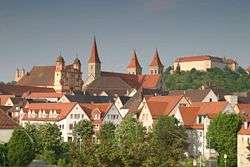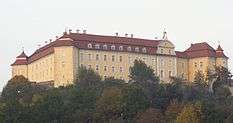Ellwangen
| Ellwangen | ||
|---|---|---|
 | ||
| ||
 Ellwangen | ||
Location of Ellwangen within Ostalbkreis district _in_AA.svg.png)
 | ||
| Coordinates: 48°57′40″N 10°7′50″E / 48.96111°N 10.13056°ECoordinates: 48°57′40″N 10°7′50″E / 48.96111°N 10.13056°E | ||
| Country | Germany | |
| State | Baden-Württemberg | |
| Admin. region | Stuttgart | |
| District | Ostalbkreis | |
| Government | ||
| • Lord Mayor | Karl Hilsenbek (Ind.) | |
| Area | ||
| • Total | 127.45 km2 (49.21 sq mi) | |
| Population (2015-12-31)[1] | ||
| • Total | 26,574 | |
| • Density | 210/km2 (540/sq mi) | |
| Time zone | CET/CEST (UTC+1/+2) | |
| Postal codes | 73479 | |
| Dialling codes | 07961, 07965 | |
| Vehicle registration | AA | |
| Website | www.ellwangen.de | |
Ellwangen an der Jagst, officially Ellwangen (Jagst), in common use simply Ellwangen is a town in the district of Ostalbkreis in the east of Baden-Württemberg in Germany. It is situated about 17 kilometres (11 mi) north of Aalen.
Ellwangen has 25,000 inhabitants.
Geography
Ellwangen is situated in the valley of the river Jagst, between the foothills of the Swabian Alb and Virngrund (ancient Virgundia) forest, the latter being part of the Swabian-Franconian Forest. The Jagst runs through Ellwangen from south to north.
History
The town developed in the 7th century as an Alemanic settlement in the Virgunna forest next to the Franconian-Swabian border. In 764 the Frankish noble Hariolf, Bishop of Langres, founded a Benedictine monastery, Ellwangen Abbey, on a hill next to the settlement. The monastery was mentioned in a document of Louis the Pious as Elehenuuwang in 814. It became a Reichsabtei in 817.
From 870 to 873 the Byzantine Greek "Apostle of the Slavs" Saint Methodius was imprisoned in Ellwangen, after he had been arrested by Ermanrich, bishop of Passau. He was set free in 873 thanks to the intervention of Pope John VIII.
The monastery was "exempt" from 1124 on (maybe earlier), which means it was directly responsible to the pope. The abbots were granted Reichsfreiheit in 1215. The office of Vogt was first held by the counts of Oettingen, from 1370 on by the counts of Württemberg. In 1460 the abbey was converted into an exempt house of secular canons, led by a prince-provost and a chapter consisting of 12 noble canons and 10 vicars. Initially its territory included the districts of Ellwangen, Tannenberg and Kochenburg. The district of Rötlen was acquired in 1471, Wasseralfingen in 1545, and Heuchlingen in 1609.
In 1588 and from 1611 to 1618 about 450 people in Ellwangen were killed in witch-hunts.
After the German Mediatisation of 1802, Ellwangen became a part of the duchy of Württemberg. At first it was the government seat of Neuwürttemberg, the territories Württemberg had acquired by mediatisation. In 1803 the town became centre of a district (Oberamt), which in 1806 was included into the new Kingdom of Württemberg. In 1807 Ellwangen became seat of the Jagstkreis (Jagst District), until the district was merged into a larger unit in 1924. The king of Württemberg, who had acquired large areas with a predominantly Roman Catholic population, wanted Ellwangen to become the seat of a Roman Catholic diocese. To achieve this, he founded in Ellwangen in 1812 an ordinary and a seminary, as well as a Roman Catholic theological faculty. The faculty was soon moved to Tübingen, where it became part of Eberhard Karls University. The seminary and the ordinary went in 1817 to Rottenburg am Neckar, which became in 1821 the seat of the newly formed diocese for Württemberg.
20th century
After World War II members of the 17th SS Panzergrenadier Division were convicted of a number of war crimes, involving the shooting of foreign concentration camp prisoners in Ellwangen during the war.[2][3][4]

In April 1945, US Army troops occupied Ellwangen and until 1946, stationed various Army units at the kaserne — the former German Tank School. From 1946 the International Refugee Organisation (IRO) used the kaserne as a displaced persons camp for 3,000 Ukrainian refugees until 1951. In 1951, the US Army — the combat engineer battalion and medical battalion of the 28th Infantry Division again took over the facility. In September 1955 the Americans returned the kaserne to the German government.[5]
Buildings



Sights of the city are the medieval town centre with its churches, notably Ellwangen Basilica. Also well known are the Baroque pilgrimage church, Schönenberg, and the castle, both on hills near to the city.
Mayors since 1819
|
|
International relations
Twin towns — Sister cities
Ellwangen is twinned with:
Sons and daughters of the town
.jpg)
- Johann Sebastian von Drey (1777-1853), catholic theologian and professor at the Ellwangen university
- Philipp Jenninger (born 1932), politician (CDU), president of the Bundestag from 1984 till 1988
- Wolfgang Benz (born 1941), historian and head of Center for Research on Antisemitism at the Technical University of Berlin 1990-2011
- Paul Wengert (born 1952), from 2002 till 2008 Lord mayor of Augsburg
- Thomas Geisel (born 1963), politician (SPD), since 2014 Lord mayor of Düsseldorf
References
- ↑ "Gemeinden in Deutschland nach Fläche, Bevölkerung und Postleitzahl am 30.09.2016". Statistisches Bundesamt (in German). 2016.
- ↑ "Case Nr.111". Justiz und NS-Verbrechen (Nazi Crimes on Trial) Vol. III. Retrieved 23 July 2015.
- ↑ "Case Nr.111". Justiz und NS-Verbrechen (Nazi Crimes on Trial) Vol. III. Retrieved 23 July 2015.
- ↑ "Case Nr.111". Justiz und NS-Verbrechen (Nazi Crimes on Trial) Vol. III. Retrieved 23 July 2015.
- ↑ "Ellwangen Kaserne, Ellwangen, unknown date". Retrieved 23 July 2015.
External links
| Wikimedia Commons has media related to Ellwangen (Jagst). |
| Wikisource has the text of the 1879 American Cyclopædia article Ellwangen. |
- Official website of Ellwangen (German)
- Schoenenberg: images
- Ellwangen Basilica: images
-
 "Ellwangen". Encyclopædia Britannica (11th ed.). 1911.
"Ellwangen". Encyclopædia Britannica (11th ed.). 1911. -
 "Ellwangen". New International Encyclopedia. 1905.
"Ellwangen". New International Encyclopedia. 1905.
